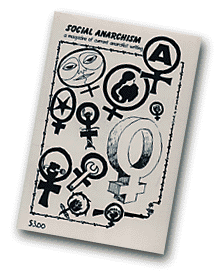Toward a General Theory of Anarchafeminism
December 26, 2005
People who are familiar with theories of social anarchism and feminism are invariably struck by their similarities. Both sets of theories view social and economic inequality as rooted in institutionalized power arrangements; both stress the necessity of changing those arrangements as a precondition for liberation; and both work for the realization of personal autonomy and freedom within a context of community.
The essays of such writers as Elaine Leeder, L. Susan Brown, Peggy Kornegger, Carol Ehrlich, Neala Schleuning, and Jane Meyerding blend together in an extraordinary manner, While they all promote an anarchist feminist position, each uniquely grapples with the differences between that position and other varieties of feminism. This is where we have to start. I think we need to look at the basic statements of feminist theories and observe how people come to endorse some statements and not others.
All feminist theories start with a set of observations about women in society. These three statements represent the core of those observations.
The women's movement divided on the problems of existing inequalities among women, particularly those of social class, ethnicity and skin color. Both ideologically and from the standpoint of organizing a movement, these divisions proved as difficult for the feminist movement as they were for the larger society. For some feminists, these were not perceived as issues; while for others, they were seen as subordinate to the struggle for power. Still others, mainly radical feminists, split over the process by which matters of class, ethnicity and color should be incorporated into the women's movement.
For the varieties of radical feminists (and anarchists are one of those), there are additional belief statements that make up their theories. Central to all of the radical perspectives is an insistence on the consistency of means and ends, especially in one's everyday life.
Because cultures distinguish people on the basis of gender, females have a range of experiences that are different from those of males. Even similar experiences will carry different meanings. The consequence is that women (and men) have developed distinctive subcultures. Recognition of this cultural difference is expressed in another belief statement of feminist theory.
Most radical feminists believe that the elements of women's culture are preferable to their male analogs in the dominant culture. Some radical feminists understandably stop at this point, choosing to live (and work, if possible) within a women's community. Some, claiming the superiority of women's culture, and often, by implication, the superiority of women, have argued that a society controlled by women would not have the oppressive characteristics of patriarchal societies. Some of them have developed matriarchal theories of past and future societies.
Like all political theories, radical feminism has a set of statements on how change is to come about. (Many of these are expressed in my essay "Building a revolutionary transfer culture" (Social Anarchism, 4, 1982). Central to the feminist transfer culture are two requirements:
To be free from coercion means that one has to live in a society where institutionalized forms of power, domination and hierarchy no longer exist. For anarchists, power is the central issue.
Anarchist feminists know what other radicals often have to learn from bitter experience: the development of new forms of organization designed to get rid of hierarchy, authority, and power requires new social structures. Further, these structures must be carefully built and continually nurtured so that organizations function smoothly and efficiently, and so that new or informal elites will not emerge. If there is an underlying principle of action it is that we need to cultivate the habits of freedom so that we constantly experience it in our everyday lives.
Elaine Leeder points out in her essay "Let Our Mothers Show the Way," that it was anarchist women who extended the boundaries of male-dominated anarchist thought. To be sure, sexist anarchists existed then, as now, but as Susan Brown noted it is "only by virtue of contradicting their own anarchism."
Works Cited
The essays cited in text by Brown, Ehrlich, Kornegger, and Leeder all appear in Howard J. Ehrlich, ed., Reinventing Anarchy, Again (Edinburgh and San Francisco: AK Press, 1994).
The essays of such writers as Elaine Leeder, L. Susan Brown, Peggy Kornegger, Carol Ehrlich, Neala Schleuning, and Jane Meyerding blend together in an extraordinary manner, While they all promote an anarchist feminist position, each uniquely grapples with the differences between that position and other varieties of feminism. This is where we have to start. I think we need to look at the basic statements of feminist theories and observe how people come to endorse some statements and not others.
All feminist theories start with a set of observations about women in society. These three statements represent the core of those observations.
- The social roles ascribed to women and men are primarily culturally determined.
- Women are discriminated against in all sectors of society — personally, socially, occupationally, and politically.
- Women are physically objectified and, as a consequence, routinely harassed and assaulted sexually.
- Women and men are equal.
The women's movement divided on the problems of existing inequalities among women, particularly those of social class, ethnicity and skin color. Both ideologically and from the standpoint of organizing a movement, these divisions proved as difficult for the feminist movement as they were for the larger society. For some feminists, these were not perceived as issues; while for others, they were seen as subordinate to the struggle for power. Still others, mainly radical feminists, split over the process by which matters of class, ethnicity and color should be incorporated into the women's movement.
For the varieties of radical feminists (and anarchists are one of those), there are additional belief statements that make up their theories. Central to all of the radical perspectives is an insistence on the consistency of means and ends, especially in one's everyday life.
- The personal is the political.
Because cultures distinguish people on the basis of gender, females have a range of experiences that are different from those of males. Even similar experiences will carry different meanings. The consequence is that women (and men) have developed distinctive subcultures. Recognition of this cultural difference is expressed in another belief statement of feminist theory.
- There is a separate, identifiable women's subculture in every society.
Most radical feminists believe that the elements of women's culture are preferable to their male analogs in the dominant culture. Some radical feminists understandably stop at this point, choosing to live (and work, if possible) within a women's community. Some, claiming the superiority of women's culture, and often, by implication, the superiority of women, have argued that a society controlled by women would not have the oppressive characteristics of patriarchal societies. Some of them have developed matriarchal theories of past and future societies.
Like all political theories, radical feminism has a set of statements on how change is to come about. (Many of these are expressed in my essay "Building a revolutionary transfer culture" (Social Anarchism, 4, 1982). Central to the feminist transfer culture are two requirements:
- The individual working collectively with others is the locus of change.
- Alternative institutions built on principles of cooperation and mutual aid are the organizational forms for this change.
- All people have a right to be free from coercion, from violence to their mind or body.
Just as one can be a feminist and oppose power…it is also possible and not inconsistent for a feminist to embrace the use of power and advocate domination without relinquishing the right to be a feminist.
To be free from coercion means that one has to live in a society where institutionalized forms of power, domination and hierarchy no longer exist. For anarchists, power is the central issue.
- One should neither submit to nor exercise power over other people.
Anarchist feminists know what other radicals often have to learn from bitter experience: the development of new forms of organization designed to get rid of hierarchy, authority, and power requires new social structures. Further, these structures must be carefully built and continually nurtured so that organizations function smoothly and efficiently, and so that new or informal elites will not emerge. If there is an underlying principle of action it is that we need to cultivate the habits of freedom so that we constantly experience it in our everyday lives.
Elaine Leeder points out in her essay "Let Our Mothers Show the Way," that it was anarchist women who extended the boundaries of male-dominated anarchist thought. To be sure, sexist anarchists existed then, as now, but as Susan Brown noted it is "only by virtue of contradicting their own anarchism."
Works Cited
The essays cited in text by Brown, Ehrlich, Kornegger, and Leeder all appear in Howard J. Ehrlich, ed., Reinventing Anarchy, Again (Edinburgh and San Francisco: AK Press, 1994).
Next: The Politics of Sleep

